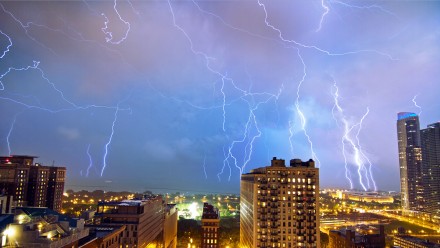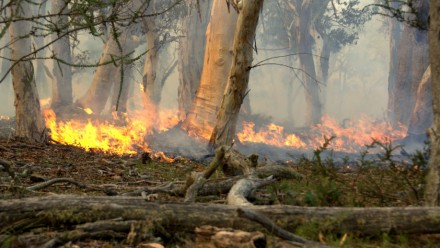Extreme events and future scenarios
As the world has warmed, due to anthropogenic greenhouse gas emissions, there has been a marked change in both the frequency and intensity of extreme weather events. Since 1980, the frequency of storms with winds stronger than 250km has more than tripled.
Globally, economic losses associated with weather-related disasters in 2018 were estimated at US $215 billion. Insurance companies in Australia did not escape these impacts with $1.2 billion in claims paid out following major extreme weather related events. These costs represent a conservative assessment of the associated costs of extreme events to both national and global economies.
Extreme events often do not occur in isolation but can be exemplified by a combination of extreme winds, rainfall amounts and rainfall intensity. These compound extreme, defined as the simultaneous or sequential occurrence of multiple extremes at singular or multiple locations, have the capacity to make the impact of related extreme events far worse than one extreme in isolation.
In this theme, researchers are focused on understanding the primary drivers of changing frequency and intensity of extreme events and exploring links with climate change. Extreme event detection and attribution such as this is a rapidly expanding area of climate science.
ANU researchers are also looking at future scenarios and exploring possible responses, both in terms of mitigation and adaptation.
Leaders
Researchers
- Professor Nerilie Abram
- Professor Owen Atkin
- Dr Amita Bansal
- Admiral (Ret) Chris Barrie
- Associate Professor Cristopher Brack
- Dr Adam Broinowski
- Dr Thang Bui
- Professor Colin Butler
- Stephen Bygrave
- Dr David Caldicott
- Salā Dr George Carter
- Professor Geoff Cary
- Associate Professor Sarah Clement
- Dr Helen Adair Cleugh
- Dr Tom Cliff
- Dr Steven Cork
- Dr Charlie Crimston
- Ms Kathryn Dan
- Professor Katherine Daniell
- Professor Hugh Davies
- Mr Clem Davis
- Professor Stephen Dovers
- Associate Professor Benjamin Edwards
- Dr Marwan El Hassan
- Professor James Fox
- Dr Richard W. Frank
- Professor Alan Gamlen
- Dr Robert Glasser
- Dr John Handmer
- Dr Naomi Hay
- Dr Timothy Heffernan
- Dr Mina Henein
- Dr Prabhasri Herath
- Professor Andy Hogg
- Dr Will Howard
- Emeritus Professor Mark Howden AC FTSE FAA
- Dr Arnagretta Hunter
- Professor Lorrae Van Kerkhoff
- Professor Penelope King
- Dr Steven Lade
- Dr Voon Hui Lai
- Emeritus Professor Shirley Leitch
- Dr Zoe Leviston
- Dr Sophie Lewis
- Dr Nicola Maher
- Dr Joice Mathew
- Associate Professor Adrienne Nicotra
- Emeritus Professor Ian Noble
- Dr Tayanah O'Donnell
- Professor Sarah Perkins-Kirkpatrick
- Dr Thanh-Son Pham
- Associate Professor Roslyn Prinsley
- Dr Simon Quilty
- Professor Eelco J Rohling
- Prof Penny Sackett
- Dr Kayla Smurthwaite
- Associate Professor Katie Steele
- Dr Firouzeh Taghikhah
- Professor John Taylor
- Dr Stephen Tims
- Prof Brian Walker
- Professor Iain Walker
- Professor Robert Wasson
- Assoc Prof Bob Webb
- Associate Professor Carina Wyborn
- Dr Nicolas Younes
Students
- Anupiya Ellepola
- Rocco Fabrizio Notarnicola
- Shima Farazmehr
- Roshen Fernando
- Adrian Hindes
- Vitor Hirata Sanches
- Maegan Miccelli
- Ruby Olsson
- Cynthia Parayiwa
- Caroline Rosello
- Rachel Taylor
Professional staff
2022
Response of the East Antarctic Ice Sheet to past and future climate change, Chris R Stokes, Nerilie J Abram, Michael J Bentley, Tamsin L Edwards, Matthew H England, Annie Foppert, Stewart S R Jamieson, Richard S Jones, Matt A King, Jan T M Lenaerts, Brooke Medley, Bertie W J Miles, Guy J G Paxman, Catherine Ritz, Tina van de Flierdt and Pippa L Whitehouse, Nature.
Designing climate information services to enhance resilient farming activities: Lessons from Papua New Guinea, Rachel S Friedman, Steven J Crimp, Ruth Baiga, Kasis Inape, Ellis Mackenzie and Mark Howden, Frontiers in Climate.
Facilitating learning for innovation in a climate-stressed context: insights from flash flood-affected rice farming in Bangladesh, Md Kamruzzaman, Katherine Anne Daniell, Ataharul Chowdhury and Steven Crimp, The Journal of Agricultural Education and Extension.
Disaster Risk Reduction in Asia Pacific - Governance, Education and Capacity – new publication, this book brings together interdisciplinary perspectives from across the Asia-Pacific region; focuses on how societies in the Asia-Pacific approach disaster planning, preparation, planning, recovery, and resilience; and addresses different dimensions of Sendai Framework of Disaster Risk Reduction. Edited by Helen James, Rajib Shaw, Vinod Sharma and Anna Lukasiewicz.
Engaging with the future: framings of adaptation to climate change in conservation, Claudia Munera-Roldan, Matthew J. Colloff, Bruno Locatelli, Carina Wyborn, Ecosystems and People.
2021
Energy insecurity during temperature extremes in remote Australia, Thomas Longden, Simon Quilty, Brad Riley, Lee V White, Michael Klerck, Vanessa Napaltjari Davis & Norman Frank Jupurrurla, Nature Energy.









